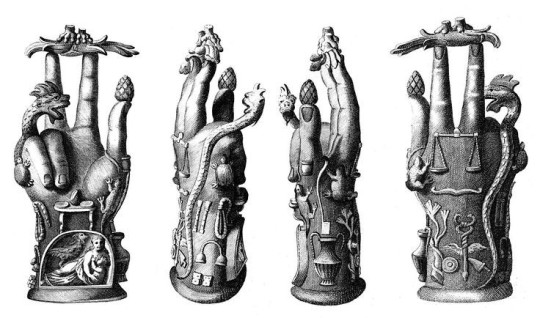#Sabazios
Photo

Bronze hand used in the worship of Sabazios. Hands decorated with religious symbols were designed to stand in sanctuaries or, like this one, were attached to poles for processional use.
Date: Roman 1st–2nd century AD.
Collection: British Museum.
2K notes
·
View notes
Text

“Triballorum ac Serborum principatum”
86 notes
·
View notes
Photo

MYSTICUM “Lost Masters of the Universe” (Great compilation with tracks taken from the "Wintermass" Demo 1993, "Medusa's Tears" Demo 1993, Split EP 1994 and "Piss Off !!!" promo tape 1995).
“Flames are crawling upon my face
I’m running after my shade
Out of sunlight and into darkness
Into my crypt of fear
Into my crypt of fear
Out of sunlight
Into Darkness
I’m chased by my own fear
The unholy master is watching me
Is it Him the devil that is torturing me
Close my coffin and let me see
Into my crypt of fear
Out of darkness
And into the twilight
I feel like a demon in the night
Flames are crawling like pets on me
The shades aren’t here to see
With my master the devil my friend
My soul will slave for eternity”
https://peaceville.bandcamp.com/album/lost-masters-of-the-universe
#Mysticum#Sabazios#Black Metal#Industrial Black Metal#Prime Evil#Dr. Best#Cerastes#Planet Satan Revolution#Peaceville Records#Wintermass#Black Magic Mushrooms#Piss Off !!!
6 notes
·
View notes
Text

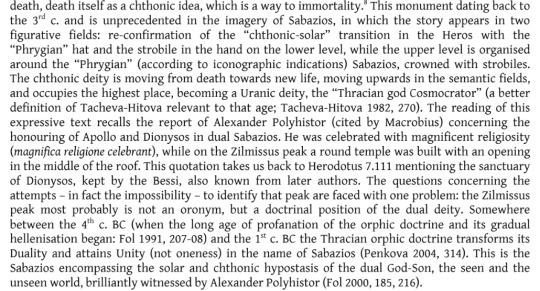
"The cult of Sabazios in the North Black Sea - Via Thrace?", Ruja Popova
6 notes
·
View notes
Text
Theory: The name "Sabazios"
The Phrygians were a nation that interacted with the ancient Greeks from at least the 7th century BCE. Being an Indo-European group, their mythology matches Greek and Roman pantheons almost one-for-one. A notable example is Sabazius (Σαβάζιος), their paternal sky-god associated with horses and lightning.

Sabazius was considered by some to be the son of Kubeleya (Cybele)
The name Sabazius has an uncertain etymology. It's assumedly a Hellenized form of a Phrygian name, but knowledge of the Phrygian language is limited due to its scarce attestation. I have a theory of where the name may come from based on sound changes and comparative mythology.
Firstly, the symbols associated with Sabazius (clouds, horses, thunder, the heavens) link him with various other Indo-European chief gods (Perkūnas, Deipatura, Dyaush, etc.) so his name may stem from a common Proto-Indo-European term for "deity." Usually the chief god of an Indo-European pantheon has no personal name, but is instead referred to with a title and an honorific (e.g. "Sky Father", "All Father", "King of the Gods") and "Sabazius" may be no different.
The element Ζιος seems to come from an earlier Ziwos (Ζιϝος), which ultimately stems from Proto-Indo-European "Deywós" ("God", "Divine Being"), the root of names like "Zeus" and "Iūpiter." So without much resistance we could assume a part of Sabazius' name means "-god."
"Saba" is the challenging bit. It may stem from a native Phrygian word, but when written in the Greek alphabet its original form might have been obscured (older texts render it as "Σεβα"). It may be related to the verb "σέβομαι" ("to be in awe/admiration"), making Saba-Zios' name "The Venerable God" (fitting the deity's role), the usual scholarly conclusion.
I personally think the "saba" element may be related to the Semitic element "ṣaba" ("army"), hence "God of Armies", as Sabazius was associated with Dionysus (see Aristophanes' The Wasps) and Dionysus had an army of devoted maenads. But I guess the beauty of Greek myths is that we may never have the full set-in-stone picture, allowing for the mythology to be truly alive for each new generation.
3 notes
·
View notes
Text
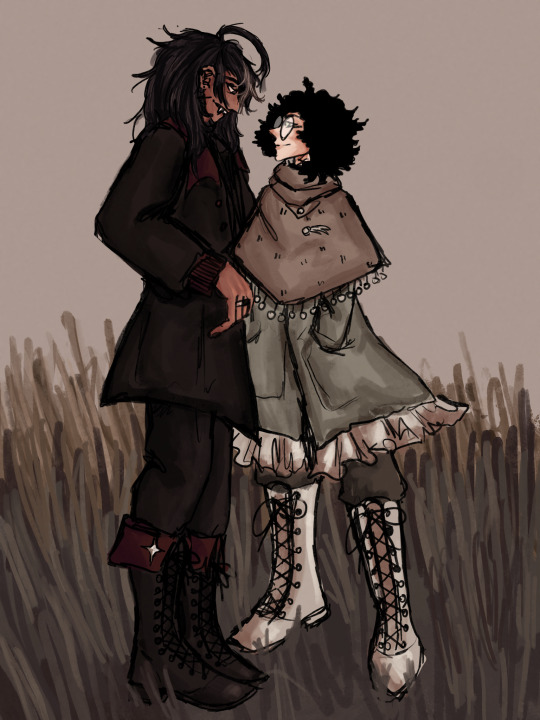
into the arms of my favorite stranger
[ID: A digital drawing of Griffin and Adel, who are standing in a brown grassy field with a white sky. Griffin, a taller man with tan skin and long brown hair, looks down at Adel, who is pale, shorter, has big curly black hair, and wears glasses. They are smiling at each other. Griffin is wearing a long black coat with red collar and sleeves, black pants, and tall black boots with a star button on them. He wears an aro and an ace ring. Adel is wearing a brown capelet with a comet brooch on it, a green coat with a white ruffle, and tall white boots. End ID]
ref below cut
tags: @halsdaisy / send an ask off anon if you want to be added to the list!

[ID: a photograph of two people facing each other in a grassy field with a white sky, their heads are out of the shot. The left figure is in a black coat with tall black boots, the right one is in a longer black coat with tall white boots. End ID]
#the lyric is from maintain the madness by the jane austen segument#argument*#im so normal about that song#im in love with their differing color schemes#griffin’s dark and warm while adel’s light and cold#minkydraws#its a stormy day maybe but the rain has just cleared up#theyve stopped for some fresh air in the sabazio countryside#sure adels only been here six years which is relatively few#compared to the mob members who have been performing their whole lives#but when youre in love with the heir of the troupe and the son of its matriarch#you learn a couple things about operations#i wonder what they’re talking about#the dancing plague
14 notes
·
View notes
Text
Dionysus & Bacchus cheat sheet deep dive

Signs he's reaching out • smelling wine all of a sudden, craving wine, You feel a twinge of madness, dreams with his attributes with him, seeing references of him everywhere
Herbs •psalakanthos plant, Grapes and their vines, Figs, Bay laurel, Barley, Pine, Pomegranate, Fennel, apples, berries, weed, Silver Fir, Bindweed, poppy, wheat and hops leafs, wildflowers, pine cones, Apple seeds, Blazing star. I think he would like Cinnamon, mint, feverfew (happiness), Pepper, basil, chives, horseradish (courage), orange, lemongrass, marjoram (insight), vanilla, sorrel, cinnamon (love)
Animals• Oxen and wild animals, asses, Leopards, Panther, Cheetah, serpents, rams, dolphins, tigers, lynx, panthers, goats, bats, griffons, bulls
Colors •purple, green, gold, Red, Black, White.
Patron of• fruit and intoxitation, Parties, Festivities, Banquets, Drinking, Bacchic Revelry, Madness, Bacchic Frenzy, Insanity, Hallucination, Homosexuality, Effeminacy, Cross-dressing, Forest Wilderness, Wild vegetation, Predatory big cats, Reincarnation, The path to Elysium, Comedy and Tragedy Plays, Playwrites, Actors, bartenders, the arts, non-binary people.
Curses• violence, and sickness, Destructive insanity, madness
Blessings• pleasure and fun, Religious frenzy (in the orgiastic cults), Ecstasy, Afterlife in Elysium (paradise), getting a bigger friend group, charismatic going up, getting a romantic partner.
Diety of• wine-making, orchards, fruit, vegetation, fertility, festivity, insanity, ritual madness, religious ecstasy, theatre, partying, Epiphany, weddings, death, sacrifice, sexuality, dancing, immortality, and reincarnation, uninhibited freedom, as well as the subversion of the powerful, ecstasy, and abandon, swamps and marshes.
Crystals• Amethyst, grape agate, Garnet, Ruby, deep red stones, tiger eye, serpentine, leopard jasper, amber, green opal or jade, carnelian, rose quartz (someone had it on their alter for him, so I added it here.), bloodstone, sugilite, purple fluorite, ametrine lepidolite
Mortal or immortal • immortal
Zodiac • Taruas
Vows/omans• none
Number• 7
Morals• he is morally ambiguous
Married to• Ariadne
Past lovers• Althaia, Ampelos, Aphrodite, Erigone, Kronois, Pallene, Physokoa, Polymnos.
What he favors in devotees• free-spirited, out-of-the-norm, wild lifestyle, gender fluid, transgender, nonbinary people. People are restricted wanting to become free.
Personality• He brings joy, ecstasy, and merriment, but also delivers "brutal and blinding rage”, he's a very chill guy, many say he is sassy. I met him once, and he respects people's boundaries.
Home• Mount Olympus
Equivalents/most resemblance • Osiris, Hades, Sabazios, Yahweh, Bacchus, Liber, Tammuz, Orotalt, Fufluns, Acan, Jesus.
Epithets• Acratophorus, Ἀκρατοφό.ρος “giver of unmixed wine at Phigaleia in arcadia, Acroreites at Sicyon Adoneus a Latinised form of Adonis and is also used as an epithet for Bacchus, AegobolusΑἰγοβόλος "goat-shooter" at Potniae in Boeoria, Aesymnetes Αἰσυμνήτης “ruler" or "lord" at Aroë and Patrae in Achaea, Agrios Ἄγριος "wild", in Macedonia, Androgynos Ἀνδρόγυνος ”Androgynous” specifically in intercourse referring to the god taking both an active male and a passive female role, Anthroporraistes, Ἀνθρωπορραίστης “man-destroyer" a title of Dionysus at Tenedos, Bassareus, Βασσαρεύς "fox-skin", which item was worn by his cultists in their mysteries. Bougenes, Βουγενής or Βοηγενής “borne by a cow", in the Mysteries of Lerna,
Braetes, Βραίτης "related to beer" at Thrace, Briseus Βρῑσεύς "he who prevails" in Smyrna, Bromios Βρόμιος "roaring” and "roar of thunder" refering to the wind amd primarily relating to the central death/resurrection element of his myths and also the god's transformations into lion and bull and of those who drink alcohol and refers to Dionysus' father, Zeus "the thunderer", Choiropsalasχοιροψάλας “pig-plucker" Greek χοῖρος = "pig"(which was used as a slang term for the female genitalia as A reference to Dionysus's role as a fertility deity), Chthonios Χθόνιος “the subterranean”, Cistophorus Κιστοφόρος "basket-bearer and ivy-bearer" because baskets are sacred to the Dionysus,Dimetor Διμήτωρ "twice-born" which Refers to Dionysus's two births, Dendrites Δενδρίτης "he of the trees" as a fertility god, Dithyrambos Διθύραμβος used at his festivals referring to his premature birth, Eleutherios Ἐλευθέριος “the liberator" also a epithet shared with Eros, Endendros ("he in the tree"), Enorches "with balls" with reference to his fertility, or "in the testicles" in reference to Zeus' sewing the baby Dionysus "into his thigh" which means his testicles used in Samos and Lesbos, Eridromos"good-running" in Nonnus' Dionysiaca, Erikryptos Ἐρίκρυπτος "completely hidden" in Macedonia, Euaster Εὐαστήρ from the cry "euae", Euius (Euios), from the cry "euae" in lyric passages, and in Euripides’ play “the bacche, Lacchus Lακχος a possible epithet which is associated with the Elusinian Mysteries, The name "Iacchus" may come from the Ιακχος (Iakchos) whicj is a hymn sung in honor of Dionysus.
Indoletes, Ἰνδολέτης, meaning slayer/killer of Indians Due to his campaign against the Indians, Isodaetes, Ισοδαίτης, meaning "he who distributes equal portions", cult epithet which is also shared with Helios, Kemilius, Κεμήλιος and kemas: "young deer, pricket",
Liknites "he of the winnowing fan", as a fertility god connected with mystery religions ( a winnowing fan was used to separate the chaff from the grain.)
Palazzo Massimo, Rome, Lenaius, Ληναῖος "god of the wine-press", Lyaeus, or Lyaios Λυαῖος, "deliverer” and "loosener") which refers to him as who releases from care and anxiety,
Lysius, Λύσιος "delivering, releasing" At Thebes there was a temple of Dionysus Lysius, MelanaigisΜελάναιγις "of the black goatskin" at the Apaturia festival,
Morychus Μόρυχος “smeared" in Sicily, because his icon was smeared with wine less at the vintage, Mystes Μύστης "of the mysteries" at Tegea in Arcadia, Nysian Nύσιος according to Philostatus he was called like this by the Ancient indians Most probably, because according to legend he founded the city of Nysa, Oeneus, Οἰνεύς "wine-dark" as god of the wine press, Omadios “flesh-eater", Eusebius writes in Preparation for the gospel that Euelpis of Carystus states that in Chios and Tendos they did a human sacrifice to Dionysus Omadios,
Phallen , (Φαλλήν) (probably "related to the phallus” at Lesbos, Phleus "related to the bloοm of a plant", Peudanor Ψευδάνωρ "false man" referring to his feminine qualities in Macedonia,
Pericionius, Περικιόνιος "climbing the column (ivy)" a name of Dionysus at Thebes, Semeleios or Semeleius or Semeleus an obscure epithet meaning 'He of the Earth' and 'son of Semele' Also “Son of Semele, Iakchus, wealth-giver”,
Skyllitas, Σκυλλίτας “related to the vine-branch" at Kos, Sykites, Συκίτης "related to figs" at Laconia,Taurophagus, Ταυροφάγος “bull eating", Tauros Ταῦρος “a bull", Theoinus, Θέοινος wine-god of a festival in Attica, Τhyiοn, Θυίων "from the festival of Dionysus 'Thyia' (Θυῐα) at Elis", Thyllophorus, Θυλλοφόρος "bearing leaves" at Kos, Dionysus and Zeus absorbs the role of Sabazios (a Thracian/Phrygian deity)
Facts• Dionysus was the last god to enter Olympus, When Dionysus had grown up lady Hera made him into a state of madness so he wandered through many countries of the earth, He was a student of the famous centaur Chiron who taught him how to dance, The common names Dennis and Denise are said to be derived from Dionysus. he hated the sight of an owl
Roots• Ancient Greece, Greek mythology, Mount Pramnos on Ikaria
Offerings • Honey, Meat, Alcohol (especially wine), Fruit, Cakes, Poetry, Songs, Spices (ex- cinnamon), Blood or liquids resembling blood, He thinks those "wine mom" signs that you get in cheap gift shops are hilarious, Grape juice, Intoxicants, Grapes, Olive oil, Apples, Figs, Eggs, Goblets, Curved daggers, Bull horns, Snake skin, Leopard or tiger print objects, Purple candles, Theatre masks, Sexual toys, Percussion instruments, Wine bottles, Fake/toy grapes, Leaves or curls from grapevines, Pine needles, Pinecones, Apple seeds, Bindweed, Wildflowers, Toys photos or art of any big cats, snakes, Hymns, Songs you’ve written, Any art that you create, Any stories that you create, Art, pictures of the comedy, Wine corks, Wine labels, Toy or miniature drums, milk, water from the sea (he has a strong connection with the sea), Decorative beads, party beads, flashy jewelry, Wine glasses, Shot glasses, Corkscrews, Sparkling cider, Grape flavored things, Cheese, hallucinogens, Nips (small alcohol bottles), Bottle opener, Beer/soda tabs, Alcohol bottles with cool labels, Costumes, NatureFig/fig newtonsBull imagery, Donkey imagery, Bones, Antlers, Dead/preserved animals, Hiking gear, Seeds, Concert/festival tickets, Locks of hair, Shaven beard hair, Pride swag, ravagant clothes/clothes that make you feel good.
Devotional • learn about sacred sex, shamanic journeying, responsible entheogen use, and alcohol as a sacrament, read “The Secret History” book, Make a playlist for Him, Dance and sing to your favorite songs or songs you’d think He would like, Throw a feast in His honor, Remembering to take your medication and taking care of your mental health, Support/donate to your local theatre in His name, Be a part of the theatre, Stand up for those that are marginalized, Write stories/plays for Him, Invite Him to watch plays or movies with you (especially comedies or tragedies), Throw parties or attend them, Attend festivals, Attend a wine tasting, Go on wine tours, Attend parades, Masturbate or partake in sexual acts for Him (if you’re comfortable doing so And over 18), Drink alcohol or grape juice, Smoke po, Learn about winemaking, Support local vineyards, Wear wreaths made from ivy, Wear faux leopard or tiger print, Wear the color purple, Pray to Him for things while intoxicated/high, Visit your local winery and participate in a grape-stomp, do some Homebrewing in his honor, Grow a garden in his honor, Make your own ritual tools in his honor, Collect art, do Glamourbombs in his honor, Pretend to be somebody else in his honor, go out to a club in his honor, listen to music in his honor, read in his his mythos, write things for a ritual and write a prayer for him, eat some grapes or have some grape juice or sparkling grape juice (or wine if able and of age), listen to party music, read plays, watch musicals or plays (ex- high school musical, Hamilton), listen to musical soundtracks, learn about the history of theatre, learn about viticulture and vineyards, do things that bring you pleasure, listen to party soundscapes, watch documentaries about any of his sacred animals, Trip intentionally/spiritually, Learn about substance abuse/recovery, Destigamtize drug users, Learn about harm reduction, Make home videos, Write poetry, Act, Dress up, Go to the woods, Dance/sing in the woods, Meditate in the woods, Learn wilderness safety and first aid, Learn what to do when encountering a wild animal, Go off the beaten path, Explore new areas, Pick up litter, Forage, Recycle bottles, Grow fruit, Try new fruits, Have sex (let the partner know beforehand it's in Diyonisus honor, 18+), Masturbate (18+), Have threesomes/swing (ask him before and make sure the other participants know it's in Dionysus's honor, 18+.), Finally, give into that one kink you’ve been ignoring (you know the one, 18+), Learn about consent with partners, Learn how to preserve dead animals, Learn about different life cycles (ex-plants, animals), Learn about immigration in your area, Learn about different cultures, Try foreign foods, Learn a new language, Learn about your ancestry, Help immigrants in your area, Grow your hair out, Keep a Manifest/Keep a manifestation journal, Use Sexual/creative energy to manifest, Shed your old self, Do Self-reflection/self-exploration, Identify areas where you overindulge (ex- food, substances, spending).
Symbols• Grapevine, ivy, phallus, Thyrsus, theatrical masks, Leopard Skin, Panther, Cheetah, the animal called asses, cymbals, swords, or serpents, rams, laurel, asphodel, dolphins, tiger, lynx, panther, horns, goats, his chariot pulled by 2 leopards, masks in general.
Siblings• Ares, Athena, Apollo, Artemis, Aphrodite, Hebe, Hermes, Heracles, Helen of Troy, Hephaestus, Perseus, Minos, the Muses, the Graces.
His friends/gets along with• Maenads and Bacchantes and Satyrs and Sileni and Pan and Priapus
Attendees• Seilenos (God of Drunkenness), Pan (God of Shepherds & Pastures) the Satyroi and Seilenoi (spirits of Fertility & the Wild) The Bakkhantes and Mainades (Nymphe and Women revellers) Komos Satyriskos (cup-bearer)
Appearance in astral or gen• Dionysus often took on a bestial shape and was associated with various animals, often wearing an Ivy wreath, the thyrsus, and the kantharos (a large two-handled goblet) In early Greek art he has represented as a mature male, bearded and robed holding a fennel staff tipped with a pine-cone, but later on he was portrayed as youthful sensuous, naked or semi-naked androgynous youth and effeminate with brown hair and pale features, often holding grapes and drinking wine.
Parentage• Zeus and Semele, some sources also say Zeus and Demeter, some say Zeus and Persephone, but he always sends up with Persephone as a foster mother or as a biological mother, but before his reincarnation, his parents were Ammon and Amalthea.
Pet• leopards
Children • Priapus, Hymen, Thaos, Staphylus, Ononpion, Cumus, Phthonus, the Graces and Deianira, Seilenos, Pan, Satyroi & Seilenoi, Bakkhantes & Mainades, Komodo’s
season and festivles• Diyonosus festivals were bacchanalia, Dionysia, Anthesteria, Dionysian, Lenaia, Panathenaia, his season was spring and March and April
Day• 11th to the 13th of the month of Anthesterion, around the time of the January or February full moon.
Sacred places• Boitia in Greece, naxos Greek, island Edina in western Thrake, his holiest shrine was Mt kithairon (Nysa) in Boiotia Greece, he also declared war on India. A sacred place is the theatre.
Status• Greek god in the major theoi, and an agriculture Demi God.
Pet peeves• Uderestemating him, he probably won't like it if you ignore him
Music• Disco, show tunes, psychedelic rock, acid folk, Greek folk music, EDM, classical, new wave, art pop, vaporwave, just anything you can dance and sing to.
Tarot• Temperance, fool card, three of cups, the tower, 9 of cups (based off of how people see him through their tarot cards)
Scents/Inscene • Pine incense, frankensince, patchouli and vanilla, nutmeg, mulled wine, storax, and Benzoin, he dislikes lavender.
Prayers•
Regular prayer
Dionysos, god whose arrival is swift and certain, enduring friend of women and men whose welcome is warm, bringer of light, we see you in shadows. Dionysos, granter of great blessings, your presence is a heady wine. Kind-hearted god, to each you give as is fitting, each vessel you fill only as we can bear, and yet with even a sip, we are drunk upon you, and our faith is affirmed. Awesome god, by our own will we drink deeply, with you we become lost, we wander, we are found.
Litany to Dionysos
Dionysos of the vine, rich-tressed god of wine, potent and lusty, unmixed, undiluted, with full force you come to us, vital and robust, rich and strong and surprisingly sweet. Dionysos, I praise and honor you, I thank you for your blessings. Ivy-bearing Dionysos, god of the green, of the power of root on stone, the force of life that will make its own way in spite of all who labor to hold it back, no will or work can bind your might. I praise and honor you, I thank you for your blessings. Dionysos of the deep earth, of the dark world, of the unknown expanse beneath the black soil, beneath solid stone, of mysteries you know much, of death and of what lies beyond. God of secrets, I praise and honor you, I thank you for your blessings. Dionysos the inspiring, granter of words of prose or poesy, words heard best by the drunken and the mad, words forgotten with the passing of night and delight. Bacchus, granter of rare transport, I praise and honor you, I thank you for your blessings. Dionysos Soter, holder of the hearts of men, you free us from the cares of the world, each brilliant frenzied moment a shining jewel, each glimpse of the sacred more precious than gold. I praise and honor you, I thank you for your blessings. Kindly Dionysos, granter of good to men and women, giver of gifts to all who seek your blessing. Gracious Dionysos, accepter of offerings great and small, friend of mankind, I praise and honor you, I thank you for your blessings.
Regular Prayer to Dionysos
Dionysos, deep-hearted one who knows the souls of men and women, whose hand is ever open, ever within reach. Dionysos, god who runs in the dark, who sees with eyes shut tight, who dances to the heart’s strong beat, ever are you yourself, ever constant, ever changing god of those who are trapped, those who seek your truth and their own, those who seek vision beyond seeing, those who seek wisdom beyond knowledge, those who seek the self, pure and sweet, those who seek clarity beyond definition, who seek to embrace the uncertain, to hold, but loosely, to what is true beyond trust.
Regular prayer to Dionysos
I praise Dionysos, lord of the vine, lord of
the far reaches of the mind; in the thick of the woods, along darkened paths, in the shadows of dusk and of dawn, you roam the world, the satyrs and the pretty nymphs dancing in your wake. Son of Zeus and fair-haired Semele, bold-hearted Semele, who dared to look into the face of glory, beautiful Semele who you carried into life again, Semele reborn who men called Thyone; beloved of clever Ariadne, quick-witted one, so dear to your heart, your bright-eyed bride and consort; Dionysos, friend of women, friend of the blissful, wild-eyed maenads, pilgrims and pioneers, those who seek, your cheer and inspiration, those who seek your release, from sorrow and despair, those who are lost in joy, and those who have found themselves in you. Dionysos, god of the darkest dark and the deepest deep, boundless one, endless one, fathomless one, in you we see the edges of ourselves, in you, we find our life’s journey, in you we find our home.
To Dionysos
I call to Dionysos, great god of the vine,
son of thundering Zeus and headstrong Semele, loving husband of warm-hearted Ariadne. From the east you came, old before the ancients, throughout the elder world were you beloved; in Naxos and Boitia were you celebrated, in temples and in the savage wilderness, the fleet-footed maenads running in your wake. The sweetest, strongest wine is ever your drink; the mind’s release, the body’s loosening, your gift. O Dionysos; thyrsus-shaker, ivy-crowned god, we see you in the shadows, we see you on the edges, we see you in the haze of ecstasy, where we know the truth of passion, where we find
the essence of our being. Bacchus, I call to you!

| Sources & websites in comments. |
#the gods#hellenic devotion#hellenic polytheism#doing the research for you#hellenic worship#greek gods#greek mythology#qoutes#ancient greek#dionysus#greek pantheon#hellenic#dionysus deity#hellenism#dionysus worship#dionysus devotee#dionysus god#Dionysus#paganblr#paganism#polytheist#pagan#deity worship#deity work#bacchus#dionysos#the bacchae#Bacchush#hellenic gods#hellenic paganism
476 notes
·
View notes
Photo
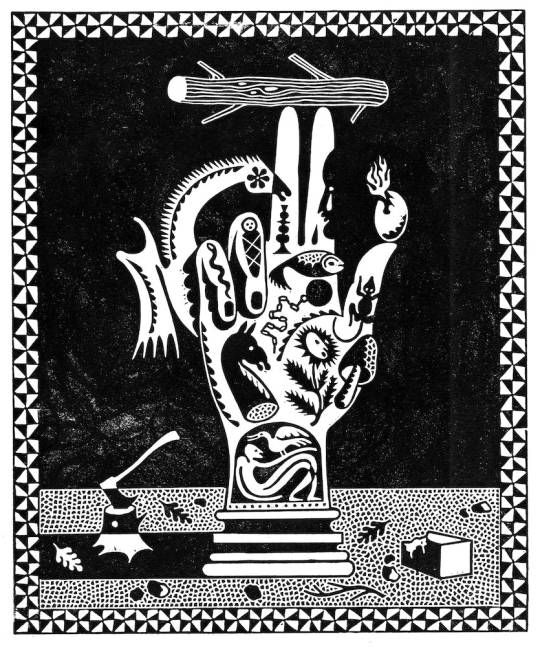
Hand of Sabazios - Sophie Hollington
857 notes
·
View notes
Text
The mysterious cult of Sabazios
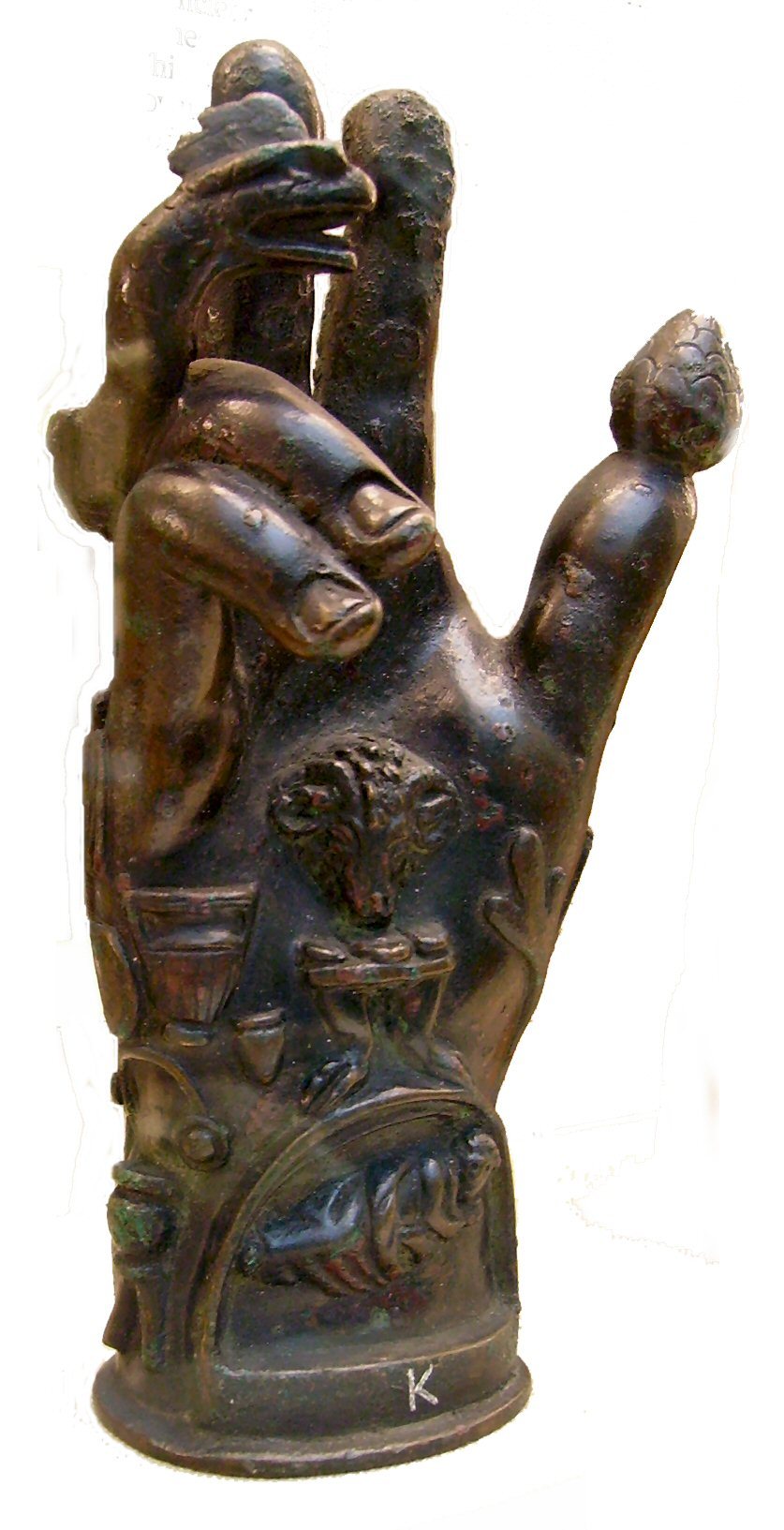
Bronze hand used in the worship of Sabazios. Roman, 1st-2nd century AD (British Museum)
Sabazios, a god of Thracian or Anatolian origin, became popular in the Roman Empire, and had connections both with Jupiter and Dionysos. Hands decorated with religious symbols were designed to stand in sanctuaries or, like this one, were attached to poles for processional use.
By: Mike Young.
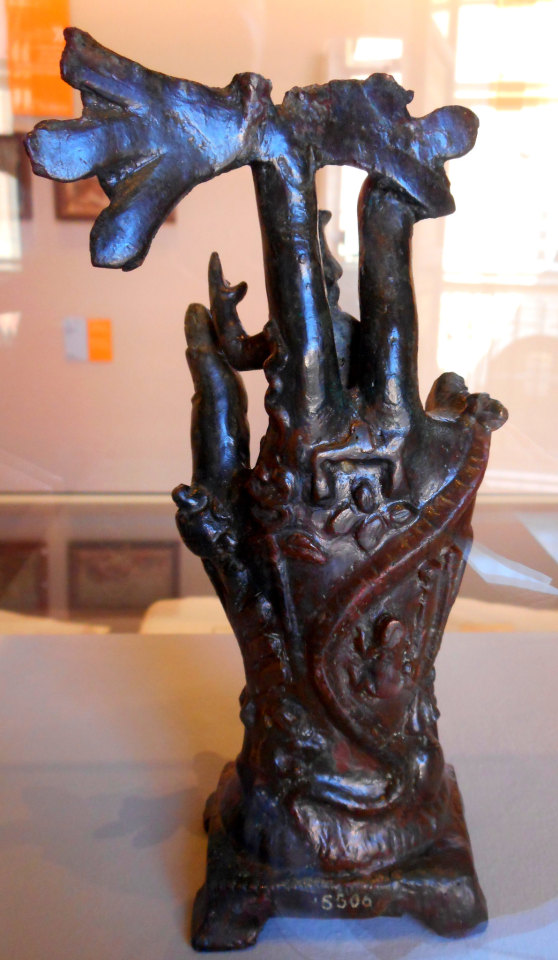
Found in Herculaneum. Photo taken by Carlo Raso at the Exhibition "Herculaneum and Pompeii: Vision of Discovery". Archaeological Museum of Naples.
References to the cult of Sabazios are found in the comedies of Aristophanes, which emphasize the non-Greek character of the god and the use of rituals full of emotion and accompanied by lively music and trance states. The cult of Sabazios was orgiastic; According to Diodorus, the rites were carried out at night and the initiation ceremonies consisted of several rites.
Strabo's Sicilian contemporary Diodorus Siculus (1st century BC) mixed Sabazios with the secret "second" Dionysus, born of Zeus and Persephone.

From the Roman period (1st century AD) found on the Island of Escombreras (Cartagena, Spain) and preserved in the National Museum of Underwater Archeology. By: Nano Sanchez.
According to modern scholars, not a single temple dedicated to Sabazios has been located in Roman sites, although an inscription built on the wall of the abbey church of San Venanzio in Ceparana, Italy, suggested to a Renaissance humanist, that it had been built on the foundations of a temple to Jupiter Sabacio. The symbolism of these objects is not well known.
Texts from Wikipedia - Public domain pictures
51 notes
·
View notes
Text
Dionysus Deity Guide
Content warning: Dionysus is linked heavily with sexuality and sexual themes will be prevalent throughout this post.

Who is Dionysus?
Also spelled “Dionysos”, he is the Greek god of wine, ecstasy, and theatre to name a few of his areas of expertise. He was later adopted by the Romans who referred to him as Bacchus. Dionysus was known as being “twice born” due to the story of his birth(s).
The story of Dionysus’ birth is a tragedy, beginning his life with his mother’s death. The story goes that Hera caught wind of Semele’s pregnancy with Zeus’ child and convinced her to ask Zeus to show her his true godly form in order to prove that he really was Zeus. This true form was too much for a mortal to handle and Semele was consumed by fire—or the heat Zeus’ lightning bolts. Not wanting his child to die with her, Zeus sewed Dionysus into his own thigh (thought to mean his testicles).
Parents and Siblings
Zeus (Father)
Semele (Mother)
Demeter (Mother, at times)
Persephone (Mother in Orphic mythos)
Siblings
Aeacus
Angelos
Apollo
Ares
Artemis
Athena
Eileithyia
Enyo
Eris
Ersa
Hebe
Helen of Troy
Hephaestus
Heracles
Hermes
Minos
Pandia
Persephone
Perseus
Rhadamanthus
Tantalus
the Graces
the Horae
the Litae
the Muses
the Moirai
Lovers or Partners
Ariadne (Wife/Consort)
Aphrodite
Aura
Beroe
Cronois
Nicaea
Althaea
Erigone
Pellene
Physcoa
Ampelus
Polymnus or Hyplipnus
Children
HYMENAIOS/Hymenaeus (Son)
IAKKHOS (Iacchus) (Son)
METHE (Daughter)
PASITHEA (Daughter)
PRIAPOS/Priapus (Son)
SABAZIOS/Sabazius (Son)
TELETE (Daughter)
THYSA (Daughter)
DEIANEIRA (Daughter)
EURYMEDON (Son)
KERAMOS/Ceramus (Son)
NARKAIOS/Narcaeus (Son)
OINOPION/Oenopion (Son)
PEPARETHOS/Peparethus (Son)
PHANOS (Son)
PHLIASOS or PHLIAS (Son)
STAPHYLOS/Staphylus (Son)
THOAS
Epithets
Note: Dionysus has many epithets and to create a list of all of them would make this post WAY too long so I’ve added as many as I could while retaining a good length for the post. :,>
Dionysus Eleutherios ("the liberator")
Acratophorus, Ἀκρατοφόρος ("giver of unmixed wine"), at Phigaleia in Arcadia
Acroreites at Sicyon
Androgynos Ἀνδρόγυνος (androgynous, specifically in intercourse) referring to the god taking both an active male and a passive female role.
Bassareus, Βασσαρεύς a Thracian name for Dionysus, which derives from bassaris or "fox-skin", which item was worn by his cultists in their mysteries.
Braetes, Βραίτης ("related to beer") at Thrace
Cistophorus Κιστοφόρος ("basket-bearer, ivy-bearer"), Alludes To baskets being sacred to the god.
Dimetor Διμήτωρ ("twice-born") Refers to Dionysus's two births.
Dendrites Δενδρίτης ("he of the trees"), as a fertility god.
Enorches ("with balls"), with reference to his fertility, or "in the testicles" in reference to Zeus' sewing the baby Dionysus "into his thigh", understood to mean his testicles). Used in Samos and Lesbos.
Iacchus, Ἴακχος a possible epithet of Dionysus, associated with the Eleusinian Mysteries. In Eleusis, he is known as a son of Zeus and Demeter. The name "Iacchus" may come from the Ιακχος (Iakchos), a hymn sung in honor of Dionysus.
Lenaius, Ληναῖος ("god of the wine-press")
Phleus ("related to the bloοm of a plant").
Pseudanor Ψευδάνωρ (literally "false man", referring to his feminine qualities), in Macedonia.
Tauros, Ταῦρος ("a bull"), occurs as a surname of Dionysus.
(Wiki)
Notes
Dionysus may have been worshipped as early as c. 1500–1100 BC by Mycenaean Greeks.
After birth Dionysus was said to have been sent to be cared for by Nymphs at Mount Nysa, the identities of these Nymphs varies by source.
His wife, Ariadne, was abandoned by Theseus on the island of Naxos. In some myths she is slain and/or ascends to immortality to live with her husband on Mt. Olympus.
Once he was an adult, Dionysus traveled to the underworld to bring his mother back with him to Olympus where it’s said that Zeus then turned her into the goddess Thyone—Goddess of the Bacchic frenzy that his female followers experience.
Dionysus is regularly found with groups of satyrs and maenads.
Another name the Greeks had for Dionysus was Bacchus, this was the name the Romans would later adopt for the god. Bacchus means “the noisy or riotous god”, fitting for this buck-wild deity! (Said with affection, of course.)
Along with wine, ecstasy, and theatre, Dionysus was known as a god of vegetation, madness, and frenzy along with quite a few other specializations.
Once a group of pirates kidnapped Dionysus who planned to sell him as a slave (or other unsavory things, depending on the myth); he overran their boat with creeping vines and beasts, and caused the men to go insane, then turned them into dolphins as they jumped overboard.
Dionysus has been depicted in many ways over time but two prevalent depictions are either him as an androgynous youth or an old, bearded man.
Apparently Dionysus hates owls; rather he hates the “sight of an owl” (Theoi)
As Bacchus he was commonly depicted as having ram or bull horns.
Dionysus had many cults throughout the ancient world including not just Greece, but in Scythia, Eastern Europe, Libya, North Africa and Gaul, Southern France as well.
Modern Deity Work
Correspondences
These are not all historically accurate. Anything that has a background in ancient tradition will be marked with a (T).
Rocks/Stone/Crystals
Grape Agate
Amethyst (it was believed that this stone could protect you from drunkenness)
Antimony
Gold
Garnet
Ruby
Herbs/Plants
Pinecone & Pine tree (due to his staff being tipped with a pinecone) (T)
Grapes/grapevines (T)
Ivy (T)
Asphodel (T)
Animals
Leopard or Panther
Tiger
Bull
Serpent
Dolphins (T)
Fawns (his followers were said to wear fawn-skins)
Important Dates
Dionysia
Haloa
Ascolia
Lenaia
Bacchanalia
Offerings
Wine (T)
Objects or imagery of the aforementioned items and animals
Fruit or fruit salad
Honey
Beer
Acts of Devotion
Go buck-wild (half joking here)
Dance
Host festivities
Sing
Attend, write, or act in a play (T)
Sign, create, or recite Hymns to Dionysus (T)
Protect or be an ally for queer, androgynous, and gender non-conforming folks
Dress up in costumes
Make a mask for him (T)
Have sex or solo sex
As the god of comedy he'd also probably enjoy stand-up comedians just sayin
Be yourself!! Dionysus is especially known to love on outcasts.
All in all, how you interact with a deity is up to you, these are simply a few suggestions for you based on my readings!
References and Further Reading
Dionysus - Britannica
Dionysus - Wikipedia
Dionysos - Theoi
The Bacchae - Ancient-Literature
The Masque of Dionysus by Helene P. Foley
The Frogs - Aristophanes (wiki summary, but there are free pdfs of the translated story!)
Misc Myths: Dionysus - Overly Sarcastic Productions
Ecstasy and Possession: The Attraction of the Women to the Cult of Dionysus
Cult of Dionysos - Theoi
349 notes
·
View notes
Text
The myth of Dionysos (7)
I covered before two articles of the "Dictionary of Literary Myths". Here I bring you another loose translation of a thorough article covering Dionysos' legend, myth and god-self. However this time, it is an article coming from Félix Guirand's "General Mythology". It is a bit of an old article - originally written in 1937 - so some elements might be lacking or outdated, but Guirand's book and studied stayed a very influential and referential work when it came to mythology studies for a very long time, up to the early 21st century, so there is a legitimate interest to put it alongside other Dionysos articles throughout this series.
In the section about Greek mythology, Félix Guirand classifies Dionysos right after Demeter among the "earth gods" and "agragrian deities".

I/ Traits and attributes
Dionysos (etymologically speaking, the “Zeus of Nysa” seems, by analogies of his attributes and legends, to be the Greek version of the Vedic god “Soma”. His cult seems to have been born in Thrace: brought to Boeotia by settling Thracian tribes, it was then carried to the island of Naxos by Boeotian colonizers, before it finally started spreading over the entire archipelago, before returning to the continental Greece – first in the Attic region, and later in the Peloponnese. The character that was the primitive Dionysos complexified itself by borrowing traits from foreign deities – most notably the Cretan Zagreus, the Phrygian Sabazios, and the Lydian Bassareus. As such, Dionysos kept gaining new domains and powers as his characterization grew. It seems that Dionysos was originally simply a god of wine. From the spirit of wine, he became a god of vegetation and hot humidity, and from this point he evolved into the god of pleasures, then into the god of civilization, and finally, according to the Orphic traditions, he reached his apex as a manifestation of the supreme deity.

II/ Cult and depictions
Dionysos was honored throughout all of Greece, but the nature of his festivities and holidays varied depending on the regions and eras. One of his most ancient celebrations was the Agrionia, that came from Boeotia (most specifically Orchomenos): in its primitive form, the Bacchants killed a young boy in honor of the god. Human sacrifices were also practiced at Chios and Lesbos – they were however replaced by ritual flagellation. In the Attic region, it was the rural Dionysia that were celebrated: in December it was the Lenaea, holidays of the wine press, when the god was offered the first products of the wine-season. Then, at the end of February, came the Anthesteria, or “flowery celebrations”, that lasted three days during which the wine of the last harvest was tasted – in the Lenoeon sanctuary a procession was organized, followed by a sacrifice offered by the wife of the archon-king, and concluded by the offering of boiled seeds to both Dionysos and Hermes. The most famed and renowned celebrations of Dionysos were however the Great Dionysia, or urban Dionysia, at the beginning of March. It was during this festival that theater plays were organized. These nobles and respectful ceremonies were coupled with orgy-like celebrations all throughout Greece – such as the orgiastic celebrations on the slopes of the Cithaeron.
The physical appearance of Dionysos changed as his legend was modified. He first appeared in the same of a mature, bearded, middle-aged man wearing a crown of ivy. Then he became an effeminate and beardless ephebe, sometimes half-naked, barely covered by a “nebride” (a panther’s pelt or fawn skin), other times wearing a long dress identical to those worn by women. His head, which sported long curly hair, was crowned with vine and grapes – he was holding in one hand a thyrsus, and in the other either grapes or a drinking cup.
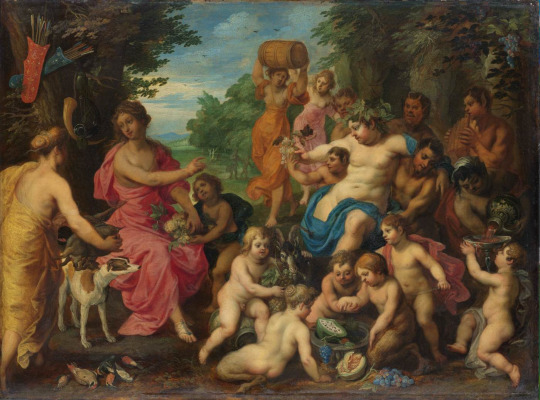
(Here I cut off parts III and IV of the article - I'll post them separately)
V/ Foreign deities associated with Dionysos
This exuberant wealth of legends is explained not only by the great popularity of the god, but also by the fact that Dionysos’ personality (as said previously) absorbed several foreign deities. Three in particular: the Phrygian Sabazios, the Lydian Bassareus and the Cretan Zagreus.
Sabazios, who was the supreme god of the Hellespontic Thrace, was a solar god from Phrygia. Very diverse traditions surrounded him: sometimes he was the son of Kronos, other times the son and lover of Cybele. His wife was either the lunar goddess Bendis, either Cotys/Cottyto, an earth-goddess similar to the Phrygian Cybele. Sabazios was depicted with horns, and the snake was his sacred animal. He was celebrated through nocturnal orgies. When later Sabazios was assimilated to Dionysos, the legends of the two gods intertwined. Some said that Sabazios has placed Dionysos within his thigh before entrusting him to the nymph Hippa ; others claimed that it was the opposite way and that Sabazios was Dionysos’ son. It is because of these parallels and links fome between the two that ultimately Dionysos’ native land was considered to be the Hellespontic Thrace.
Sometimes the Bacchants were called the “Bassarids/Bassarides”, and Dionysos himself sometimes wore the epithet “Bassarios” when he wore a long dress of Oriental style. One theory, presented by the lexicography Hesychios, was that it was a reference to the fox-skins the Bacchants used as clothing ; but another theory rather proposes the reading of these names as an allusion to an Oriental god absorbed by Dionysos. In Lydia, there was a god similar to the Phrygian Sabazios. This god was worshipped at Tmôlos, the same place where (according to the Orphico-Thracian tradition), Sabazios gave a child-Dionysos to Hippa. The Tmôlos later became one of Dionysos’ favorite residences. If this theory is correct, what was the name of this Lydian god? The hypothesis is that it might have been Bassareus – this Bassareus might have been a conquering deity, and it is because of him that the “far-reaching conquests” of Dionysos might have entered his legend. It was also probably because of Bassareus existence that Dionysos became involved in the legend of Aphrodite and Adonis, and maybe it was even because of this Bassareus that the legend of Ampelos came to be – this very beautiful young man that Dionysos was in love with, but who was killed by a wild bull he tried to tame. Dionysos, full of sorrow, asked the gods to turn Ampelos into vine.
As for Zagreus… Zagreus very probably started out as the Cretan equivalent of the Hellenistic Zeus, but under the influence of the Orphic mysticism he was identified with Dionysos, and this resulted in a new element of the Dionysos legend: Dionysos’ passion (in the Christian sense). Here is what was told about the Zagreus-Dionysos: He was the son of Zeus, and of either Demeter or Kore. The other gods were jealous of him, and thus conspired against him. He was ripped to pieces by the Titans, that then boiled his dismembered corpse. However Pallas saved the heart of the god: she brought it to Zeus, who destroyed the Titans with his thunderbolt, and from the still-beating heart he had Dionysos be born. As for Zagreus, whose remains were buried at the foot of the Parnassus, he became a chtonian deity qui, in the Underworld, welcomed the souls of the dead and helped their purification. To these sufferings and this resurrection, the adepts of the Orphism gave a mystical meaning/reading, and this deeply changed the character of Dionysos. He stopped being this rustic god of wine and joy that had descended from the mountains of Thrace – he even lost his trait as the “god of orgies and madness that came from the Orient”, no, this new Orphic Dionysos was, to take back Plutarch’s words, “the god who was destroyed, the god who disappears, the god who abandons life and then is reborn” – aka, a symbol of universal life.
As such, it is no surprise to see that in the Mysteries of Eleusis Dionysos was associated with Demeter and Kore ; because, like them, he embodied one of the great powers of fecundity in the world.

32 notes
·
View notes
Note
isn’t “iao” just an old greek transcription of the tetragrammaton? like it’s not that deep is it?
Oh good question! It depends!
Magical texts from the Ancient Mediterranean are extremely syncretic. So syncretic that the authors would regularly lose track of what symbols corresponded to what divinities. So depending on the text you're reading IAŌ can refer to:
An uncommon form of the Koine tetragrammaton
Christ
Dionysus syncretized with the phyrgian god Sabazios
Dionysus syncretized with the Jewish/Christian god via a corrupted transliteration of the Greek "Sabaṓth"
One of the chief archons of Sethian Gnosticism
A general invocation of a nonspecific divinity
302 notes
·
View notes
Text

A Roman Tiny Tortoise Figurine Found in England
In July last year, a small Roman copper alloy tortoise or turtle figurine was discovered by metal detectors near the village of Wickham Skeith in Suffolk, England.
There is no exact date, but experts date it to the early 2nd century AD, as a similar example was unearthed in settlement layers dating to around 100-400 AD during excavations in the Roman city of Colchester.
At just over one inch long and just under one inch wide, the figurine’s body is shaped like a typical turtle/tortoise shell, sub-circular in plan and D-shaped in section. While the top of the shell is very worn, it appears to have once been decorated with two sets of crescent-shaped grooves, positioned on either side of the midpoint. The figurine has a crudely shaped head protruding from the apex of the shell, and four feet projecting from the sides. The left forelimb seems to have been broken away some time ago, leaving only a short stump. There is also a small tail on the lower edge. The underside of the shell is flat and does not appear to have been decorated.
Tortoises or turtles were most often associated with the god Mercury in the Roman world and Mercury is often found accompanied by turtles/tortoises in iconography. Mercury was the god of commerce, communication and travellers. A possible reason for the association with Mercury was that tortoise shells were used for making lyres, stringed musical instruments used in antiquity, the invention of which is attributed to Mercury in mythology. It may have been associated with Sabazios, too, a god of the Phrygians and Thracians.
Metal detectorists who report their finds to the Finds Recording Team have resulted in an increasing corpus of Roman turtle/tortoise figurines in recent years. Several similar figurines have also been recorded in Suffolk, near Barking, and near Little Blakenham by the Portable Antiquities Scheme over the years.
The wee tortoise was reported to the Suffolk Finds Liaison of the Portable Antiquities Scheme for documentation and has now been returned to the finder.
The Portable Antiquities Scheme is an initiative to encourage the recording of archaeological objects found by members of the public in England and Wales.
By oguz kayra.
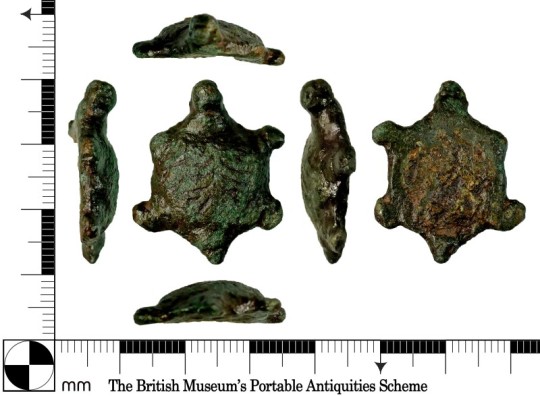
#A Roman Tiny Tortoise Figurine Found in England#Suffolk England#metal detecting#ancient artifacts#archeology#archeolgst#history#history news#ancient history#ancient culture#ancient civilizations#roman history#roman empire#roman art
33 notes
·
View notes
Text
After reading a few of books about Hekate (about her origins, mythology, symbols, devotees’ experiences, etc) I found out that to my surprise worshipping her alongside Dionysus is not as unusual as I initially thought, as I barely found anything about worshipping the two or any connection other than their aspects of rebirth months ago when I started researching about Dionysus
“…the god Dionysos, whose cult intersects with that of Hekate at various points…”
Circle for Hekate - Volume I: History & Mythology , Sorita D’Este, 2017
"The female side of the royal line was particularly devout to Dionysos, and Alexander's mother, Olympias, was well known for her exceptional loyalty to him. She was initiated into the service of Dionysos at Samothrace where the chthonic mysteries of Hekate-Brimo and her consort Dionysos/Sabazios were celebrated and the sanctuary was thereafter taken into Macedonia's protection."
Ancient Greek Divination, Johnston, 2009
#i will be posting a book recommendation list at some point!#hellenic polytheism#hellenic pagan#deity worship#deity work#dionysus deity#hekate deity
21 notes
·
View notes
Text
For my third sculpture, I've decided to try my take on the Hand of Sabazios
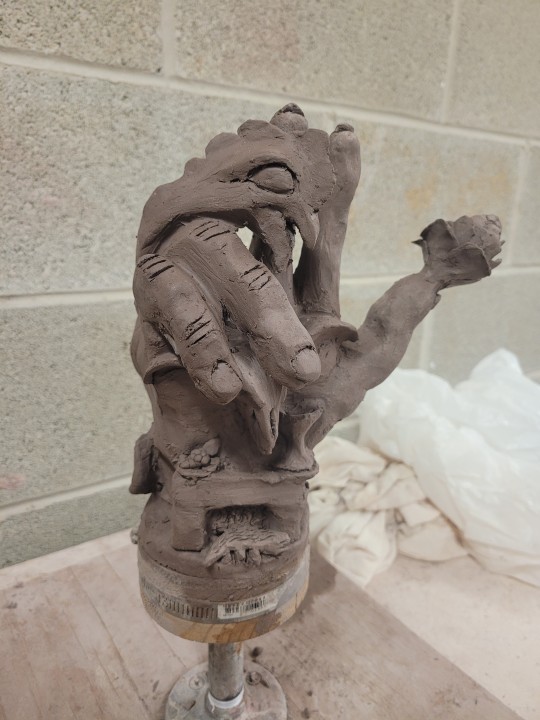

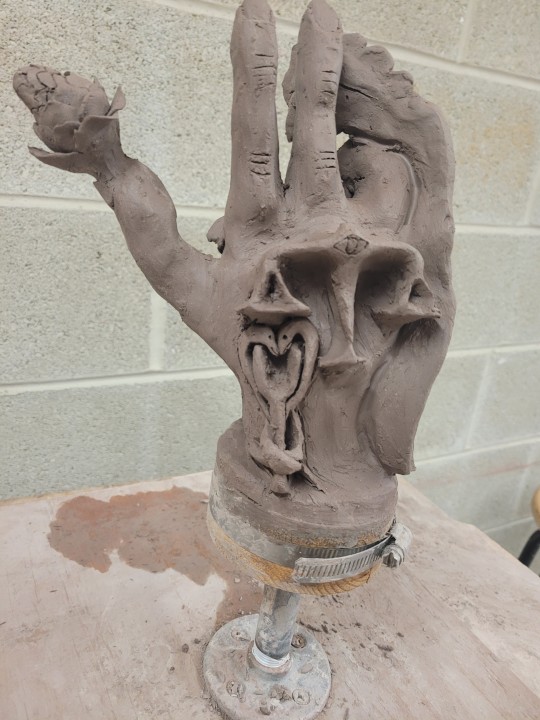
It was a very challenging project, and I think I'll revisit the subject someday, but I had a lot of fun with all the symbology.
10 notes
·
View notes
